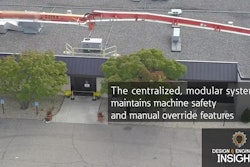
responses submitted by Astrid Mozes, Vice President, Power & Motion Controls, Eaton
Diesel, Electric and Other Power Alternatives
What role, if any, is electrification playing in your company’s design initiatives?
At Eaton, we understand that if there is significant electric power available on the machine, there are certain services where it makes sense to switch from hydraulic to electric actuation. However, there are still many cases where hydraulic actuation makes sense – and in those cases, we’re working to make the hydraulics more efficient to reduce electrical energy consumption.
Additionally, our new eMobility business focuses on delivering electric vehicle solutions to OEMs, including those developing off-highway equipment. Our Hydraulics Group is collaborating with the eMobility team to develop optimized solutions that manage hydraulic and electrical power for the off-road markets.
Does your company foresee electrification playing a bigger role in the coming years, and what is needed for it to become a more widespread technology in the heavy-duty vehicle industry?
We believe that electrification will start to play a bigger role in coming years. One key area required for widespread adoption of this technology is the electrical infrastructure required for charging and powering large off-duty electric machinery. Consider the charging infrastructure for personal electric vehicles – it may be growing in some areas of the country, but it’s still a challenge to complete an all-electric long-haul road trip. As more equipment goes electric, construction sites will need to change to accommodate the electric power needs of these equipment. How will equipment be charged? Where will it be plugged in? These are questions that will need to be answered before electrification can become ubiquitous.
Data, IoT & Connectivity
What role is data playing in your company, and how do you anticipate it will grow in the coming years?
Data is the foundation upon which we build out many of the key features and advanced functionality in our products and systems. For example, our CMA and AxisPro valves both use the data collected from sensors embedded in the valves to enable advanced controls methods that are built into the software of the products. Beyond controls, we are also using data to improve product and system diagnostics. By reading and understanding data from our products, we can build programs that notify the user of concerns or even predict that a part may fail in the future. Data is the fundamental building block for these capabilities.
What benefits is the Internet of Things (IoT) bringing to your company, and/or the industry as a whole, and how do you see it continuing to be beneficial in the coming years?
Across the heavy-duty vehicle industry, the connectivity between devices and the cloud or internet enables remote monitoring of the health of the machine and makes it possible to automate machine functions. IoT will also play a role in automation between machines, synchronizing actuation in the field.
These technologies are making heavy equipment easier to use. Over time, we have lost a lot of fluid power specialization in the industry due to a combination of fewer schools teaching the subject, fewer students studying the subject, and the fact that more people are being trained to wear many hats. With less specialized knowledge, it is important that machinery is easier to operate and maintain. With IoT, we can deploy algorithms and diagnostics that are built into our products and send information on the health and status of the machine. Notifications on specific issues help simplify troubleshooting immensely.
Are you seeing any new opportunities in regards to connectivity, and if so, what technologies are making these possible?
In the short term, ethernet has become more accepted in the vehicle space, and we expect that to continue moving into the off-road market as well. As there is more data gathered, there will be a need for the higher bandwidth that ethernet can provide. 5G and how it will revolutionize communication is also a hot topic.
Additionally, as we develop more connected devices that communicate in increasingly advanced ways, the importance of cybersecurity continues to grow. Smart, digitally controlled devices need to be protected from hackers. At Eaton, we have a Cybersecurity Center of Excellence that works to ensure our products are secure.
Automation & Smart Systems
What are customers/the industry looking for in smart systems, and how is your company going about providing those features?
In this industry, the base expectation for a smart system is that it needs to be digitally controlled and have a method of digital communication. Essentially, sensors will be embedded and gathering data that can be accessed on the machine or remotely via the internet of things. Beyond the basic capabilities, customers are looking to smart systems that are easy to implement and use. Products that are easy to integrate and easy to update are key. As people in our industry juggle more responsibilities, the machine needs more complex functionality without adding complexity in operation. Diagnostic capabilities are part of the equation, too, as simplifying troubleshooting is also important.
Eaton is working to provide these features by leveraging existing communication protocol standards for ease of integration, improving diagnostic capabilities, designing smart products so they are not overly complex, and improving our technical documentation to make it easier for technicians and engineers to understand how to interface with the product.
How do you see smart systems continuing to impact the industry, and what new benefits will they bring?
Smart systems are enabling and will continue to enable new levels of productivity. Our boom stability control system is a great example of this. This is a control algorithm developed for our CMA valve that stabilizes the operation of a machine with a flexible boom. The system lowers the barrier of training required for an operator to be successful and productive on the machine, while making the machine safer to use.
Challenges & Opportunities
Are there any technologies or trends which you are currently excited about in the heavy-duty vehicle industry, or most looking forward to seeing in the coming years?
As the on-road space is adopting more powerful electronic components such as processors, increased capabilities such as automation can come along for the ride. Additionally, with access to more data, there is a large push in the IoT and analytics space to get into edge computing. By crunching significant amounts of data on the machine itself and leveraging machine learning, we can improve diagnostic capabilities and develop predictive maintenance solutions.
Are there trends you’re seeing in other industries which you think could have an impact on the heavy vehicle market in the near future?
More advanced processors in the on-road space will likely impact the heavy-duty vehicle industry in the coming years. The on-road vehicle market is also pushing rapidly into automation capabilities. As automation becomes more mature, we expect to see more of it in the off-road industry. As automation advances, machines will be completely redesigned. When the machine no longer needs to be designed around a human operator and can instead focus on the job it needs to do, that will drive significant changes down the road. For example, the ag industry may find it more productive to have several small machines moving through a field, rather than one large one. Using many small machines is labor prohibitive today, but as automation capabilities continue to advance, machine designers can approach the needs of their customers in an entirely different way.



















